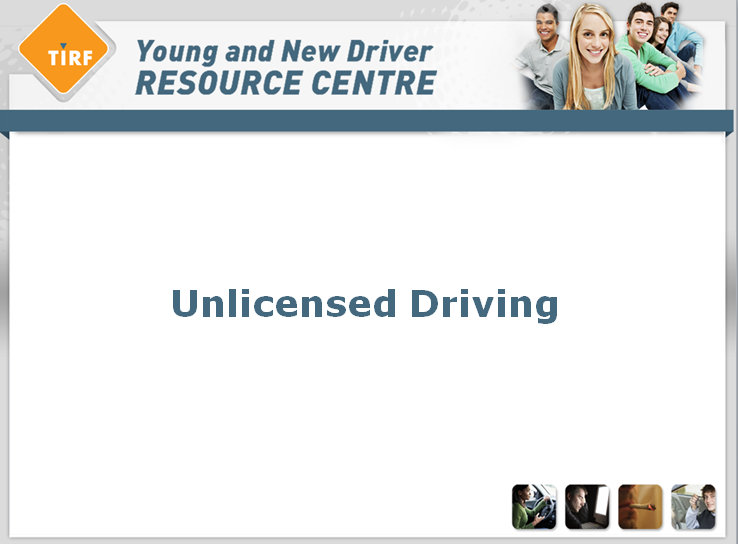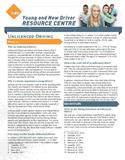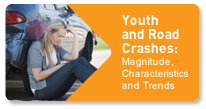The Issues - Unlicensed Driving
Coming soon...
| Video coming soon
Program:
Agency: |
Downloads

PowerPoint

Factsheet |
DEFINITION
Who are unlicenced drivers?
Why is a licence important to young drivers?
How many crashes involve unlicenced drivers?
What is the crash risk of an unlicenced driver?
BEHAVIOURS
What are the driving behaviours of unlicenced drivers?
Who is most likely to drive unlicenced?
What are the crash characteristics of young unlicenced drivers?
LEGISLATION
What will happen if a driver is caught driving unlicenced?
SOLUTIONS
What can the government and law enforcement do to reduce unlicenced driving?
What can drivers do to reduce unlicenced driving?
REFERENCES
DEFINITION
Who are unlicenced drivers?
Unlicenced drivers are drivers who have a licence that is invalid because it is suspended, revoked, inappropriate, expired or cancelled/denied, or drivers who have not gone through the process necessary to obtain a licence.1 Any driver who is driving without proper qualifications is considered unlicenced. For instance, young and new drivers must pay close to attention to the terms of graduated driver licencing (GDL) programs and understand that each licence stage may have different rules and regulations. An example of unlicenced driving would be driving without an experienced driver while holding a licence that specifies the young driver must be supervised at all times.
Why is a licence important to young drivers?
Vehicles are the most popular mode of travel, providing both the mobility and freedom2 not offered by any alternatives. Unlike public transit, vehicles can be used any time, any place, and for any purpose. For youth, they are an important tool to maintain a demanding lifestyle. For teens who want to ensure a successful future they need to be able to attend classes, participate in extra curricular activities and hold down a part time job. Without a vehicle and a licence, it is more difficult for teens to maintain a tight schedule, especially if they live far away from their school and activities.
A licence leads to both greater freedom and independence but also to an increase in responsibility. Youth who have a licence are relied upon by family members to help with household chores and errands as well as driving siblings, parents and grandparents to their destinations. If a young driver loses their licence, they are not only losing their own freedom, independence and a way to manage their busy lifestyle, but this may also leave their family without a needed source of transportation.3
How many crashes involve unlicenced drivers?
In Ontario, 2,000 fatal and injury crashes occur each year involving unlicenced drivers. Approximately 1 in 14 fatal crashes involve an unlicenced driver;4 the problem is larger in the United States (U.S.), where 1 in 5 fatal crashes involve unlicenced drivers.5 For instance, a study of California drivers found that of all drivers at fault in crashes, 35.4% were driving without a valid driver’s licence.6
According to a study conducted in the U.S., 57% of 15-year olds and 10% of 16-year olds were unlicenced at the time of a fatal crash7 and surveys show that 1 in 25 students in grades 9 to 11 have done at least some unlicenced driving.8 Unlicenced drivers under the age of 20 represent 12% of all fatal crashes in the U.S.9
What is the crash risk of an unlicenced driver?
Studies show that unlicenced drivers have an increased crash risk. They are overrepresented in fatal crashes10 and are more likely to be seriously injured in a crash. Unlicenced drivers are 11 times more likely to be involved in a serious injury crash compared to drivers with a valid licence.11
In general, unlicenced drivers take more risks when driving. They are more likely to display risky driving behaviours such as speeding, drunk driving, and running red lights. Consequently, unlicenced drivers are more likely to be at fault in crashes and they are twice as likely to have been at fault in the crash compared to those holding a valid licence.
12 Young, unlicenced drivers in particular are at serious risk if involved in a crash; 90% of unlicenced young drivers sustain an injury in a crash and a significant percentage (44.1%) of them die.
13
1 Sweedler 2007
2 Hanna et al. 2006
3 Best 2006
4 Sweedler 2007
5 Scopatz et al. 2003
6 Sweedler 2007
7 Hanna et al. 2006
8 Elliot et al. 2008
9 Hanna et al. 2006
10 Sweedler 2007
11 Blows et al. 2005
12 Blows et al. 2005
13 Hanna et al. 2006
Back to Top
BEHAVIOURS
What are the driving behaviours of unlicenced drivers?
Not only are unlicenced drivers more likely to speed, drive drunk and run red lights but they are more likely to drive a motorcycle, not use a helmet, and not wear a seat belt. They are also more likely to attempt to flee the scene at crashes in order to avoid penalties for driving unlicenced. Alcohol use is much more common among unlicenced drivers in fatal crashes; 74.1% of revoked drivers had been drinking compared with 20% of licenced drivers.14
Young unlicenced drivers are more likely to drive without a specific purpose and this puts them at higher risk of crashing compared to driving with a purpose (like going to school or work). They are also more likely to have lower grades, live in rural areas or the central city, and are less likely to have their father help them learn how to drive.15
Who is most likely to drive unlicenced?
Unlicenced drivers are more likely to be male (75%).16 Those who live in economically deprived areas (which are more likely to have poor road conditions and fewer resources such as post-trauma care) are more likely to experience a fatal crash without a valid driver’s licence. Young drivers (who already have a high crash rate) in a deprived environment are more likely to drive without a licence. These youth are also more likely to drive an older vehicle, have limited supervised driving practice time and to be unable to afford a professional driver education course.
Young drivers who are part of economically deprived families are also more likely to provide family transportation before getting their licence.17
What are the crash characteristics of young unlicenced drivers?
Crashes involving young unlicenced drivers often occur:
- between Friday and Sunday;
- between 6 a.m. and 6 p.m.;
- on high-speed roads, involving a single vehicle; and,
- with two or more occupants who are not wearing seat belts.18
14 Sweedler 2007
15 Elliot et al. 2008
16 Hanna et al. 2006
17 Hanna et al. 2012
18 Hanna et al. 2006
Back to Top
LEGISLATION
What will happen if a driver is caught driving unlicenced?
It is against the law to drive without a licence. The Criminal Code of Canada states it is illegal for a person to operate a vehicle when they are not qualified. Each province deals with the issue differently. In British Columbia, for instance, a first offender will receive a ticket and is not permitted to drive the vehicle any further. A second offender will have their vehicle impounded for seven days and are prohibited to drive until they get their licence. If a driver continues to drive without a licence after these first two offences they are penalized with a $500 fine and up to six months in jail.
In Ontario, if drivers are caught with an invalid licence, their vehicle is impounded for seven days (this includes a novice driver who is violating the GDL restrictions). The Ontario Highway Traffic Act specifies driving without a proper licence as an offence with a fine of at least $200 and up to $1,000. Novice drivers will have their licence suspended if they breach any of the GDL program requirements.
Back to Top
SOLUTIONS
What can the government and law enforcement do to reduce unlicenced driving?
Increased law enforcement and stricter penalties targeting unlicenced drivers have proven to curb this behaviour as well as reduce overall crash rates. For instance, taking away vehicle registration tags from offender licence plates so that they are easier to spot by police while driving would be an effective way to deter unlicenced driving. Some jurisdictions, such as Minnesota, go as far as confiscating licence plates and destroying them so offenders can no longer drive. Other jurisdictions, such as Fontana, California, implemented random checkpoints along the road with the goal of checking all drivers who are stopped for valid licences.19
Harsher penalties, such as vehicle impoundment or seizure, have also proven effective. Manitoba had positive results when they began impounding vehicles of anyone caught driving with a suspended licence; there was a 27% reduction in repeat offences of driving without a licence within four years and a 60% decrease in other traffic offences within 30 days following a driving without a valid licence offence.20 In California, first time offenders who had their vehicles impounded were 18% less likely to have additional convictions. They were also 25% less likely to be involved in a collision.21 Higher levels of enforcement of unlicenced driving laws also leads to a reduction in crash rates. In Fresno, California the police department saw a 30% decrease in fatal and injury crashes while implementing a program that targeted unlicenced drivers.22
There are also technologies used by police that can help in detecting unlicenced drivers. Automated Licence Plate Readers (ALPRs) “use cameras and computer software technology to scan plates of motor vehicles that are either mobile or parked. The licence plates can be checked against police and motor vehicle/drivers licence registration databases for the purposes of determining if the vehicle is stolen, unregistered or that it may be driven by a suspended or disqualified driver.
An alert given by the ALPR will signal to police that something has been detected”.23 When these devices are available, it is much easier and less time consuming for enforcement to detect unlicenced drivers.
What can drivers do to reduce unlicenced driving?
There are actions young drivers can take to ensure they are legal behind the wheel:
- Do not drive without a valid driver licence. New drivers must ensure they meet the conditions prescribed in their level of the GDL program. For instance, if a driver is driving without a supervisor and this is a requirement of their licence, their licence will be considered invalid.
- Always carry vehicle insurance that meets the minimum coverage required by provincial standards. Each province has its own insurance standards and it is the driver’s responsibility to make sure they are insured. Proof of insurance must be carried in the vehicle at all times or the driver can be penalized (e.g., fines, accumulation of demerit points for failing to show proof of insurance). Drivers should note that if they are in a crash while unlicenced, their insurance company can refuse to pay for the claim.
- Keep your driver’s licence up to date and renewed, including the stickers on your licence plate.
19 Holderness 2003
20 Beirness et al. 1997
21 DeYoung 1997
22 Fresno Police Department 1999
23 Public Safety Canada 2013
Back to Top
REFERENCES
Beirness, D.J., Simpson, H.M., Mayhew, D.R. (1997). Evaluation of Administrative Licence Suspension and Vehicle Impoundment Programs in Manitoba. Transport Canada. TP-13096E. Traffic Injury Research Foundation. Ottawa, Canada.
Best, A.L. (2006). Freedom, Constraint, and Family Responsibility: Teens and Parents Collaboratively Negotiate Around the Car, Class, Gender and Culture. Journal of Family Issues. 27(1), 55-84.
Blows, S., Ivers, R.Q., Connor, J., Ameratunga, S., Woodward, M., Norton, R. (2005). Unlicenced Drivers and Car Crash Injury. Traffic Injury Prevention. 6, 230-234.
DeYoung, D. J. (1997). An Evaluation of the Specific Deterrent Effect of Vehicle Impoundment on suspended, Revoked and Unlicensed Drivers in California.
California Department of Motor Vehicles. Sacramento, California.
Elliot, M.R., Ginsburg, F.K., Winston, F.K. (2008). Unlicensed teenage drivers: who are they and how do they behave when they are behind the wheel? Pediatrics. 122, e994-e1000.
Fresno Police Department. (1999). Traffic Offender Program Final Report. Fresno, California.
Hanna, C.L., Laflamme, L., Bingham, C.R. (2012). Fatal crash involvement of unlicensed young drivers: County level differences according to material deprivation and urbanicity in the United States. Accident Analysis and Prevention. 45, 291-295.
Hanna, C.L. Taylor, D.M., Sheppard, M.A., Laflamme, L. (2006). Fatal crashes involving young unlicenced drivers in the U.S. Journal of Safety Research. 37, 385-393.
Holderness, T. (2003). Reduce Traffic Collisions by Targeting Unlicensed Drivers. The Police Chief. 70(9). Alexandria, Virginia.
Public Safety Canada. (2013). Funding for Automated Licence Plate Readers (ALPRs) by MPI for Manitoba Police Agencies (Details). Index of Policing Initiatives. Retrieved from: http://www.publicsafety.gc.ca/cnt/cntrng-crm/plcng/cnmcs-plcng/ndx/dtls-eng.aspx?n=81.
Scopatz, R.A., Hatch, C.E., DeLucia, B.H., Tays, K.A. (2003). Unlicensed to Kill: The Sequel. AAA Foundation for Traffic Safety. Washington, D.C.
Sweedler, B.M. (2007). Unlicensed drivers: how big is the problem and what can be done about it? An International Perspective. 2nd International Traffic Expert Congress. June 2007. Vienna, Austria.
Back to Top
Last updated April 2014





